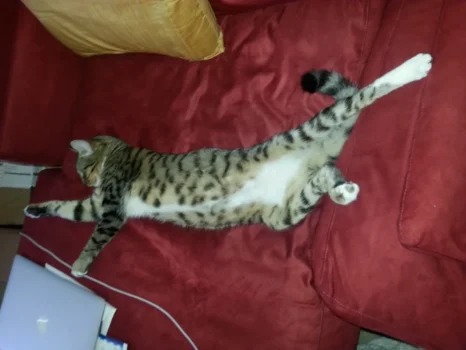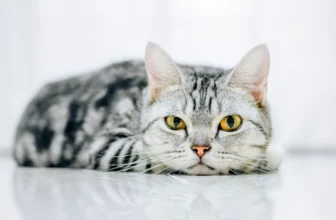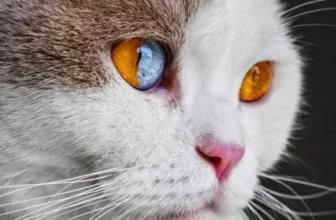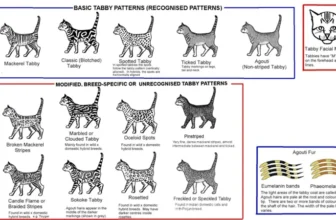Have you ever heard of a California Spangled Cat? These cats are a rare and unique breed known for their striking coat patterns and strong personalities. But did you know that understanding their body type is crucial to managing their behavior? In this article, we’ll explore the characteristics of California Spangled Cat body types and how they influence their behavior. We’ll also discuss the internal and external factors that can affect their behavior and provide tips for managing their behavior based on body type. So, whether you’re a current owner or just curious about this fascinating breed, read on to learn more!
Understanding California Spangled Cat Body Types
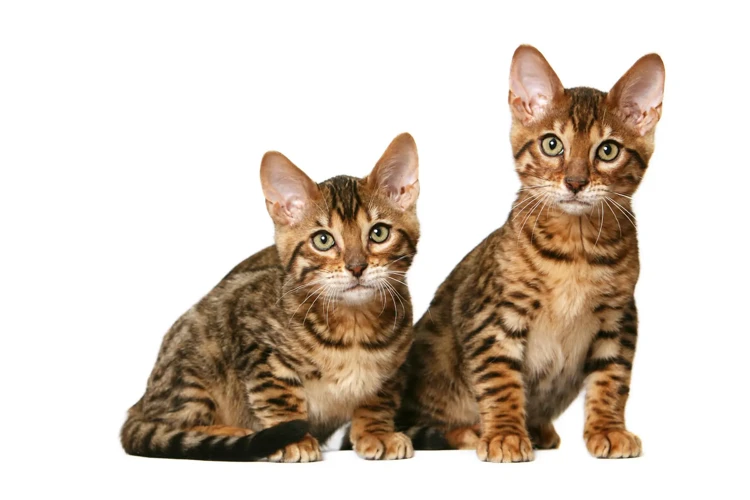
California Spangled Cats have been bred to resemble wildcats that are commonly found in nature. These cats are a unique mix of different breeds, and each has its own distinct physical and behavioral characteristics. Understanding their body type is important for owners to provide appropriate care and management to keep them healthy. In this section, we will discuss the various California Spangled Cat body types, their characteristics, personality traits, and how they behave differently based on their body type. We will dive into the five body types of California Spangled Cats, such as the Classic, Mau, Leopard, Jaguar, and Cheetah. Additionally, we will touch on the healthy weight for California Spangled Cats and how to maintain it.
Body Type Characteristics
California Spangled Cats are known for their unique body types that distinguish them from other feline breeds. These cats have five distinct body types, each with its own unique characteristics.
Hunter Body Type: The Hunter Body Type is the most muscular and athletic of all California Spangled Cat types. They have a broad chest, well-defined muscles and a strong and agile body which makes them well-suited to hunting. Hunter Body Type cats are also highly energetic and require regular physical activity to maintain good health.
Amazon Body Type: The Amazon Body Type is similar to the Hunter Body Type, but slightly smaller in size. They are agile, muscular, and athletic with a slim and long body that allows them to jump great heights. The Amazon Body Type cat is also highly active and requires regular exercise to avoid obesity.
Jungle Body Type: Unlike the Hunter and Amazon types, the Jungle Body Type is medium in size. They have a robust and well-built body with strong legs and a wide chest. Jungle Body Type cats are known for their gentle nature, which makes them great family pets.
Leopard Body Type: The Leopard Body Type of California Spangled Cat is small in size with a slender and lean body that is ideal for traversing rugged terrain. These cats have long legs which, to some extent, explains their agility. They have a wild and curious nature which makes them great explorers.
Cheeta Body Type: The Cheeta Body Type is the smallest of all California Spangled Cat types. They have a petite and lightweight body that is finely tuned for speed, agility, and quick reflexes. The body type also has a distinctive elegance about it which is accentuated by the cat’s noticeable lack of body fat.
California Spangled Cats have a natural tendency to maintain a healthy weight, and pet owners should strive to maintain this balance. A cat’s weight should never exceed 10 pounds for any body type. A balanced lifestyle, diet, and regular exercise will contribute significantly to maintaining California Spangled Cats’ good health and well-being.
Read more: California Spangled Cat Body Types Explained
Personality Traits
California Spangled cats are known for their unique personality traits, which vary depending on their body type. Let’s take a closer look at the distinctive personalities that each body type exhibits.
| Body Type | Personality Traits |
|---|---|
| Standard | The standard California Spangled cat is known to be highly energetic and playful. They love to be the center of attention and enjoy interacting with their human family members. They are also very intelligent and can be trained to do tricks and respond to commands. |
| Muscular/Heavy | The muscular/heavy California Spangled cat is typically the most laid-back and relaxed of all the body types. They are happy to lounge around and enjoy quiet time, but they still have bursts of energy and playfulness. They are also very affectionate and enjoy cuddling with their owners. |
| Shorthair/Lean | The shorthair/lean California Spangled cat is the most active and athletic of all the body types. They enjoy running, jumping, and climbing, and need plenty of space to exercise. They are also very independent, and may not be as affectionate as other body types. |
| Longhair/Light | The longhair/light California Spangled cat is the most sensitive and emotional of all the body types. They are very in tune with their owners’ moods and emotions, and may become anxious or agitated if their environment or routine changes. They are also very loyal and make great companion animals. |
| Mixed | The mixed California Spangled cat can exhibit traits from any of the other body types. As such, their personality can be somewhat of a surprise, and it may take some time to figure out their likes and dislikes. However, they are typically very adaptable and can fit into a variety of different environments. |
Understanding the unique personality traits of your California Spangled cat can help you better manage their behavior and ensure that they are receiving the appropriate care and attention. For more information on California Spangled cat body types, check out our article on 5 California Spangled Cat Body Types. And if you’re looking to maintain your California Spangled cat’s healthy weight, be sure to read our article on California Spangled Cats: Maintaining a Healthy Weight.
Behavioral Differences Based on Body Type
It’s essential to note that a California Spangled Cat’s behavior may vary based on their body type. Here are some of the most common behavioral differences based on body type.
| Body Type | Behavioral Differences |
|---|---|
| Standard | California Spangled Cats with the standard body type tend to be highly active and energetic. They love playing and interacting with humans. |
| Muscular | Cats with muscular body types are much stronger and more powerful than standard California Spangled Cats. As a result, they tend to be more independent and adventurous. |
| Large | California Spangled Cats with large body types often have an insatiable appetite. They are highly intelligent and crave mental stimulation. |
| Heavy | Cats with heavy body types tend to be more laid-back and relaxed than other body types. They enjoy lounging around and cuddling with their owners. |
| Small | California Spangled Cats with small body types may be more reserved and shy compared to the other body types. They also enjoy playing but may need some extra encouragement and attention. |
Understanding these behavioral differences based on body type can help you manage and address any concerns or difficulties you may encounter with your cat. If you want to learn more about these body types, you can check out our article on California Spangled Cat Body Types.
Factors That Influence California Spangled Cat Behavior
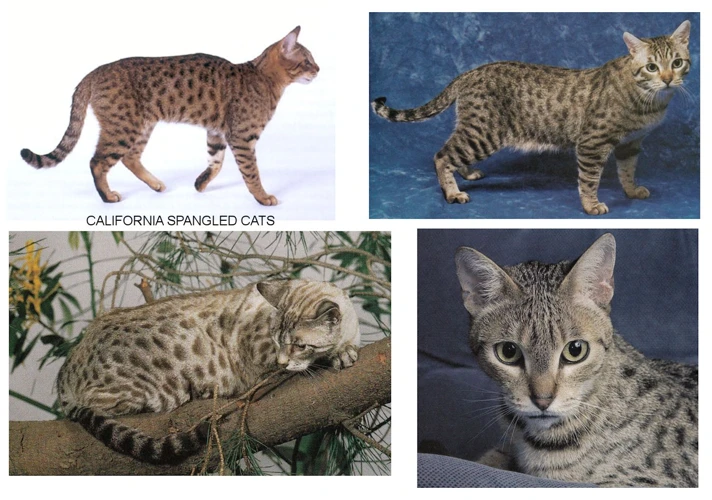
Understanding what affects the behavior of California Spangled cats is crucial for their proper care and management. While genetics play a significant role in shaping a cat’s behavior, there are also environmental and lifestyle factors that can impact their temperament and mood. By taking a closer look at these internal and external influences, cat owners can gain a better understanding of their feline companion’s needs and provide them with the best possible care. Let’s explore these factors in more detail.
Internal Factors
California Spangled Cats, like any other species, have a unique set of internal factors that influence their behavior. These factors are intrinsic and cannot be changed. However, understanding these factors can help cat owners provide their feline friends with the appropriate care and support to nurture their natural behavior. Here are some internal factors that are known to influence the behavior of California Spangled Cats.
| Factor | Description |
|---|---|
| Genetics | California Spangled Cats are a selectively bred cat. Their genetics play a significant role in their behavior, including their socialization skills and temperament. |
| Age | The age of a California Spangled Cat is a significant factor influencing its behavior. Young cats, for example, are more playful and energetic, while senior cats tend to be more sedentary and placid. |
| Gender | Male and female California Spangled Cats have different behavior traits. Male cats tend to be more social and active than female cats, who are often more independent and reserved. |
| Health | The physical and mental health of a California Spangled Cat plays a crucial role in its behavior. Illness, pain, and stress can cause changes in behavior, including aggression, loss of appetite, and lethargy. |
| Personality | Each California Spangled Cat has a unique personality, just like humans. Some cats are more outgoing and adventurous, while others are shy and reserved. Understanding your cat’s personality can help you provide it with the appropriate support. |
It’s essential to understand that all of these factors play a role in shaping a California Spangled Cat’s behavior. The key to managing a cat’s behavior is to provide it with appropriate care that addresses its intrinsic needs. External factors like diet, exercise, and environment can also influence the behavior of cats, which will be discussed in the upcoming sections of this article.
External Factors
External factors can greatly affect a California Spangled Cat’s behavior. Here are some important factors to consider:
1. Environment: The environment plays a big role in a cat’s behavior. A noisy or chaotic environment can cause stress in California Spangled Cats, which can lead to aggression or anxiety. Creating a calm and quiet environment for your cat can help reduce stress and promote positive behavior.
2. Socialization: The socialization your California Spangled Cat receives can have a significant impact on their behavior. If your cat is not exposed to other people or pets, they may become fearful or aggressive towards strangers. Socializing your cat early on can help them adjust to new situations and individuals.
3. Diet: A cat’s diet can also affect their behavior. Feeding your California Spangled Cat a well-balanced diet that meets their nutritional needs can keep them healthy and happy. On the other hand, feeding your cat a diet that lacks essential nutrients can lead to behavioral problems and health issues.
4. Exercise: Exercise is important for a cat’s physical and mental health. Regular physical activity can help reduce stress and anxiety in California Spangled Cats. Not getting enough exercise can lead to behavioral problems, such as destructiveness or aggressiveness.
5. Medical conditions: If your California Spangled Cat is experiencing a sudden change in behavior, it’s important to rule out any underlying medical conditions or illnesses. Cats may act out if they are in pain or discomfort, so it’s important to take them to the veterinarian if you notice any sudden changes in their behavior.
It’s important to consider these external factors when managing your California Spangled Cat’s behavior. Taking the necessary steps to create a calm and positive environment, socializing your cat, feeding them a balanced diet, providing exercise opportunities, and monitoring their health can help ensure that your cat has a happy and healthy life.
How to Manage California Spangled Cat Behavior Based on Body Type
As a California Spangled cat owner, understanding how to manage your cat’s behavior is essential for maintaining a happy and healthy feline. Since their behavior can vary based on their body type, it’s important to approach their care with this in mind. By implementing various training techniques, considering their diet and nutrition, and making environmental modifications, you can create an environment that caters to your feline’s individual needs based on their body type. Let’s delve deeper into management techniques for California Spangled cat behavior based on body type.
Training Techniques
When it comes to training California Spangled Cats, there are a few key techniques that can be effective regardless of the cat’s body type. Here are some training techniques to try:
- Positive Reinforcement: This technique involves rewarding your cat for good behavior, rather than punishing them for bad behavior. Positive reinforcement can include treats, toys, or verbal praise. This will help your cat associate good behavior with positive outcomes.
- Clicker Training: Clicker training involves using a clicker to mark desirable behavior, followed by a reward. This technique can be highly effective for teaching complex behaviors or tricks.
- Target Training: This involves teaching your cat to touch a target, such as a stick or your hand, and then rewarding them for doing so. This technique can be useful for teaching your cat to come when called or to jump through hoops.
- Desensitization: If your cat is fearful or anxious about certain things, such as being picked up or being around strangers, desensitization can be a useful technique. This involves gradually exposing your cat to the thing they are afraid of, in a controlled and positive way, until they become more comfortable with it.
Remember to be patient and consistent when training your California Spangled Cat. Some cats may take longer to learn certain behaviors than others, but with patience and persistence, you can help your cat become well-behaved and obedient. Additionally, it is important to never use physical punishment or yell at your cat during training, as this can damage your bond with your pet and make them fearful or aggressive.
Diet and Nutrition Considerations
When it comes to managing the behavior of your California Spangled Cat, their diet and nutrition are important considerations to keep in mind. Here are some key points to keep in mind:
- Protein: California Spangled Cats require a high-protein diet to maintain their lean, muscular body type. Look for cat food brands that have named sources of protein (such as chicken or fish) listed as the first ingredient on the packaging.
- Fats: Fats are also an important part of a California Spangled Cat’s diet, providing them with energy and promoting healthy skin and coat. Look for cat foods with moderate to high amounts of healthy fats such as Omega-3 and Omega-6 fatty acids.
- Carbohydrates: While carbohydrates are not essential to a cat’s diet, they can provide them with energy. However, it’s important to choose a cat food brand that uses complex carbohydrates (such as brown rice) rather than simple carbs (such as corn or wheat), as these provide more sustained energy for your pet.
- Water: Make sure your California Spangled Cat always has access to fresh, clean water, as cats require a lot of hydration to maintain their health and well-being. Consider purchasing a cat water fountain to encourage your pet to drink more water throughout the day.
- Feeding schedule: Establishing a regular feeding schedule can help your California Spangled Cat feel more secure and content in their environment. Avoid free-feeding your pet, as this can lead to overeating and obesity. Instead, feed them smaller, more frequent meals throughout the day.
- Supplements: In some cases, your California Spangled Cat may benefit from certain supplements to support their overall health and behavior. Consult with your veterinarian to determine which supplements are appropriate for your pet.
By keeping these diet and nutrition considerations in mind, you can help your California Spangled Cat maintain a healthy weight, a glossy coat, and a happy, well-adjusted demeanor.
Environmental Modifications
Making environmental modifications can be very beneficial for managing California Spangled Cat behavior based on body type. Here are some ideas to try:
- Provide vertical space: Cats love to climb, so consider adding cat trees or window perches.
- Offer hiding spots: Cats also love to feel secure, so adding hiding spots like covered beds or boxes can be helpful.
- Enrich the environment: Provide toys and interactive playtime to keep your cat mentally stimulated.
- Limit access to certain areas: If you have a California Spangled Cat with a more aggressive body type, you may need to limit their access to certain areas of the house or provide barriers to keep them separated from other pets or people.
- Create a consistent routine: Cats thrive on routine, so establishing consistent playtime, feeding schedules, and sleep times can be helpful in managing behavior.
Remember, every California Spangled Cat is unique and may respond differently to environmental modifications. It’s important to monitor your cat’s reactions and adjust as needed. With patience and consistency, you can create a positive and comfortable environment for your furry feline friend.
Conclusion
In conclusion, owning a California Spangled Cat can be a rewarding and fulfilling experience for any cat lover. These cats have a unique and distinct body type, with strong, muscular legs and a slender torso. They also have specific personality traits that distinguish them from other cat breeds and make them wonderful companions.
Understanding the California Spangled Cat’s body type characteristics is essential in managing their behavior. Different body types may offer various challenges and require different training techniques, dietary considerations, and environmental modifications. Additionally, there are internal and external factors that can influence their behavior, such as genetics, health, and environmental stressors.
Fortunately, there are many strategies cat owners can use to manage their California Spangled Cat’s behavior. By implementing effective training techniques, providing a balanced diet, and creating a safe and stimulating environment, owners can ensure their cats lead happy and healthy lives.
Overall, the California Spangled Cat is a fascinating breed that requires some extra attention and care. By understanding their unique body type, personality traits, and behavioral tendencies, owners can provide the best possible care and enjoy a happy and rewarding relationship with their furry friend. So, if you’re considering bringing a California Spangled Cat into your home, be prepared for a fun and fulfilling journey of discovery.
Frequently Asked Questions
What is the history of the California Spangled Cat breed?
The California Spangled Cat breed was developed in the 1980s by Paul Casey who wanted to create a domestic cat that resembled a wild jungle cat. The breed was created by crossing various breeds including the Egyptian Mau, American Shorthair, Abyssinian, and British Shorthair.
What are the physical characteristics of a California Spangled Cat?
California Spangled Cats have a lean and muscular body, with an elongated neck and long legs. They have a short, dense, and shiny coat that comes in many colors including gold, bronze, and silver. They have almond-shaped eyes that can be green, blue or gold and large rounded ears.
What type of personality do California Spangled Cats have?
California Spangled Cats are known for being loving, highly intelligent, and playful. These cats thrive on human interaction and need plenty of attention. They are also fiercely independent and curious creatures that enjoy exploring their environment.
Do California Spangled Cats have any health problems?
California Spangled Cats are generally healthy and have no known breed-specific health issues. However, like all cats, they can be prone to common ailments like dental disease and obesity if not properly cared for.
How much exercise do California Spangled Cats need?
California Spangled Cats are highly energetic and need plenty of exercise to maintain their physical and mental health. They are active cats that enjoy games, puzzles, and playtime with their human companions. Daily exercise through playtime and interactive toys is recommended.
Are California Spangled Cats good with children?
Yes, California Spangled Cats are good with children. They are highly social creatures that enjoy human company and are known for being affectionate and playful with children. However, it is always important to supervise interactions between young children and cats to ensure safety for both parties.
Can California Spangled Cats be trained?
Yes, California Spangled Cats are highly intelligent and can be trained just like dogs. They respond well to positive reinforcement and reward-based training methods.
Do California Spangled Cats shed a lot?
California Spangled Cats have a short, dense coat that sheds moderately. However, with regular brushing and grooming, shedding can be kept to a minimum.
How can I keep my California Spangled Cat happy and healthy?
To keep your California Spangled Cat happy and healthy, provide them with plenty of exercise, a healthy diet, and regular grooming. Regular veterinary check-ups are also important to maintain their health and well-being.
Are California Spangled Cats hypoallergenic?
No, California Spangled Cats are not hypoallergenic. Although they shed moderately, they produce the Fel d 1 protein which is a common allergen in cats.

